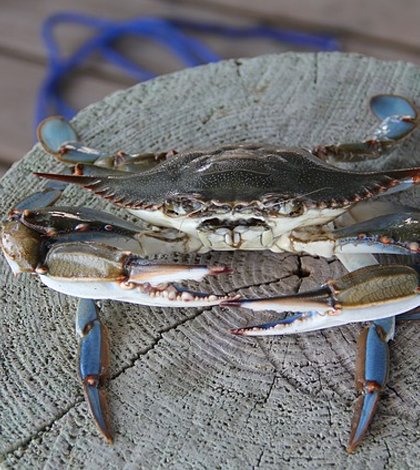Dissolved Oxygen Needs Of Blue Crabs Go Up As Water Temperatures Rise

A blue crab. (Credit: Public Domain)
With an eye toward the effects of predicted future low oxygen levels in the world’s coastal waters, researchers at the Virginia Institute of Marine Science (VIMS) have zeroed in on blue crabs, according to a release. They studied the crabs’ abilities to respond to hypoxic conditions at the school’s Eastern Shore Laboratory.
Their study, published in the Journal of Experimental Marine Biology and Ecology, details the methods and results of the work that gauged crabs’ metabolic response to different changes. These included temperature fluctuations and being infected by a common crab parasite. Findings were collected in the lab using respirometers to gauge how the crabs responded and to identify at what low-oxygen conditions they can continue to survive.
“Because coastal hypoxia can significantly impact the movements, distribution, growth and reproduction of inshore fish and invertebrate species, understanding their ability to tolerate hypoxia is becoming crucial; especially in species of ecological and commercial importance,” said Rich Brill, an adjunct faculty member at VIMS and fishery biologist with the National Marine Fisheries Service, in the statement.
Brill, who served as the study’s lead author, says that the team’s findings, which are much different than those from earlier investigations, are in large part owed to the updated technology available today. By contrast, earlier scientists recorded data with paper and pencil. They also transferred crabs back and forth between different tanks without making adjustments for how that could influence their stress. That’s something that has been found to influence respiration.
Some of the updated tech includes fiber optic and fluorescent sensors that are able to capture the oxygen usage of crabs every second. These were used in closed tanks with a pre-programmed monitoring system.
“With the ability to automate the whole data-recording system,” says Brill in the release, “we were able to collect data with minimal human intervention, and — more importantly — around the clock and for several days. This allowed us to not start the low-oxygen trial until we were sure the effects of handling and transfer had completely dissipated.”
What the trials showed was that blue crabs are oxygen regulators. In other words, they can maintain a steady metabolic rate until oxygen levels reach certain critical conditions. That’s in contrast with earlier studies that found crabs’ metabolic rates simply dropped in lockstep with declining dissolved oxygen levels.
But the critical oxygen level varied depending on each crab’s metabolic rate, researchers found. They changed water temperatures, fed the crabs or infected them with parasites to see how the rates adjusted and how oxygen needs fluctuated along with them.
The critical oxygen level needed was less than 2 milligrams per liter at 62 and 72 degrees Fahrenheit. With a bump of 10 degrees warmer, at 82, dissolved oxygen needed went up to between 2 and 3 milligrams per liter. Greater oxygen need was also evident in recently fed crabs and those that had been infected with the parasite.
“Our results are consistent with the oxygen levels shown to influence blue crab behaviors in both field and laboratory settings,” says Brill in the statement, and “support the idea that blue crabs are well adapted to the hypoxic conditions occurring in the estuarine environments they occupy.”
At reasonable water temperatures, scientists say the crabs can survive at dissolved oxygen levels as low as 1.3 milligrams per liter, or just 15 percent of the oxygen typically available in fully saturated water.
But the more important find is the effects that warmer waters have on blue crabs’ metabolic rates and the amounts of oxygen they need. After all, water temperatures in Chesapeake Bay, where many blue crab populations thrive, are predicted to go up 3.5 to 9 degrees Fahrenheit in the future. They have already gone up around 2 degrees since 1960.
“Our data show that the metabolic rates of blue crabs increase with increasing temperature, and this in turn increases the lowest oxygen levels they can survive,” said Brill in the release. “So warming of the Bay will exacerbate the effects of hypoxia on blue crabs, as it will with almost all other organisms.”
Top image: A blue crab. (Credit: Public Domain)




0 comments